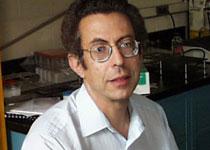My research philosophy is to bring a physical, problem-oriented approach to the acquisition and interpretation of biomolecular structural information. I view biological molecules as amazing machines that have reached the ultimate miniaturization possible in a universe composed of atoms and molecules; my approach is to pick interesting examples where it appears possible to develop understanding of how they work.
For example, my lab is studying α-synuclein, a neurologically important, natively unfolded protein implicated in a class of neurodegenerative diseases, such as Parkinson’s disease. They are termed synuclienopathies because they are characterized by deposits containing large amounts of α-synuclein. Exciting progress includes the crystallization of a GST- α-synuclein fusion protein; the crystals diffract to 2.2 Å resolution. The GST portion has been localized by molecular replacement. It is likely that most of the α-synuclein portion of the fusion protein is disordered and fills virtually all of the solvent channels implying solvent-like properties i.e. that α-synuclein can act as a macromolecular cosolvent, in addition to it’s other functions. We are now exploring the hypothesis that α-synuclein can function physically in that role because of the obviously important biological implications.
Another project is in collaboration with Michael Grabe (Pitt), Jeffrey Abramson (UCLA), and Ernest Wright (UCLA). We are applying computational methods to the group of membrane co-transporters that use a common structural motif known as a 5-helix inverted repeat; they have recently emerged as one of the largest structural classes of secondary transporters actively driving sugars, amino acids and neurotransmitters against an osmotic gradient; sodium gradients are a frequent energy source. We are focusing on the bacterial sugar transporter vSGLT as a model system to ask questions including the following: 1. How do sodium and galactose interact during their release from their respective binding sites in the cytoplasmic-facing state of the protein? 2. How does water move through this transporter? Recent results include the observation that sodium must exit before sugar can enter the cytoplasm. We also observed that a significant amount of water penetrates the transporter through the sugar binding site. Our simulations suggest that water can passively permeate the transporter, and that sugar may also actively ‘pump’ water – a result that we are attempting to confirm now.
Watanabe, A., S. Choe, V. Chaptal, J.M. Rosenberg, E.M. Wright, M. Grabe, and J. Abramson (2010)
Watanabe, A., S. Choe, V. Chaptal, J.M. Rosenberg, E.M. Wright, M. Grabe, and J. Abramson (2010) The mechanism of sodium and substrate release from the binding pocket of vSGLT. Nature 468:988-991
Choe, S., J.M. Rosenberg, J. Abramson, E.M. Wright, and M. Grabe (2010) Water permeation through
Choe, S., J.M. Rosenberg, J. Abramson, E.M. Wright, and M. Grabe (2010) Water permeation through the sodium-dependent galactose cotransporter vSGLT. Biophys J 99:L56-L58
Hennessy, D.N., B. Narayanan, and J.M. Rosenberg (2009) Automatic implementation of precise grid
Hennessy, D.N., B. Narayanan, and J.M. Rosenberg (2009) Automatic implementation of precise grid screens: the four-corners method. Acta Crystallogr D 65:1001-1003
Sapienza, P.J., J.M. Rosenberg, and L. Jen-Jacobson (2007) Structural and thermodynamic basis for
Sapienza, P.J., J.M. Rosenberg, and L. Jen-Jacobson (2007) Structural and thermodynamic basis for enhanced DNA binding by a promiscuous mutant EcoRI endonuclease. Structure 15:1368-1382
Gopalakrishnan, V., G. Livingston, D. Hennessy, B. Buchanan, and J.M. Rosenberg (2004) Machine-le
Gopalakrishnan, V., G. Livingston, D. Hennessy, B. Buchanan, and J.M. Rosenberg (2004) Machine-learning techniques for macromolecular crystallization data. Acta Crystallogr. D 60:1705-1716
Klumpp, L.M., A.T. Mackey, C.M. Farrell, J.M. Rosenberg, and S.P. Gilbert (2003) A kinesin switch
Klumpp, L.M., A.T. Mackey, C.M. Farrell, J.M. Rosenberg, and S.P. Gilbert (2003) A kinesin switch I arginine to lysine mutation rescues microtubule function. J. Biol. Chem. 278:39059-39067
Klumpp, L.M., K.M. Brendza, J.M. Rosenberg, A. Hoenger, and S.P. Gilbert (2003) Motor domain muta
Klumpp, L.M., K.M. Brendza, J.M. Rosenberg, A. Hoenger, and S.P. Gilbert (2003) Motor domain mutation traps kinesin as a microtubule rigor complex. Biochemistry 42:2595-2606
Hennessy, D., B. Buchanan, D. Subramanian, P.A. Wilkosz, and J.M. Rosenberg (2000) Statistical me
Hennessy, D., B. Buchanan, D. Subramanian, P.A. Wilkosz, and J.M. Rosenberg (2000) Statistical methods for the objective design of screening procedures for macromolecular crystallization. Acta Crystallogr. D. 56:817-827
Gopalakrishnan, V., B.G. Buchanan, and J.M. Rosenberg (2000) Intelligent aids for parallel experi
Gopalakrishnan, V., B.G. Buchanan, and J.M. Rosenberg (2000) Intelligent aids for parallel experiment planning and macromolecular crystallization. ISMB 8:171-182
Dr. Rosenberg received his Ph.D. in 1974 from the Massachusetts Institute of Technology and joined the Department in 1978.

